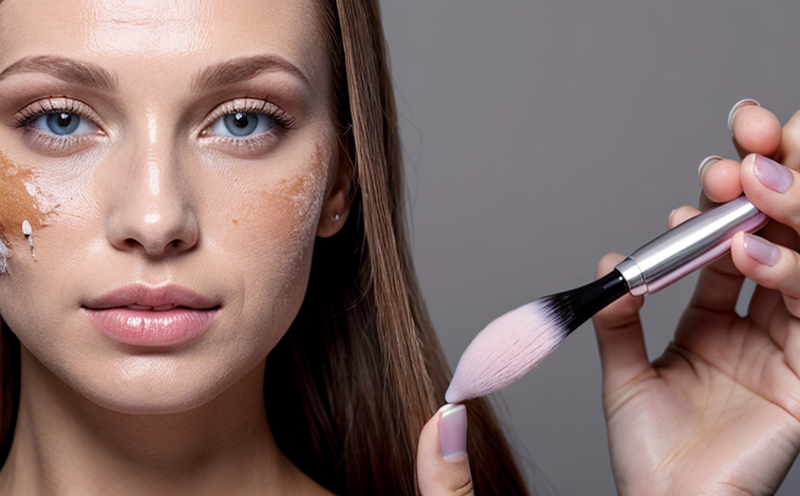ISO 24444 SPF Testing for Sunscreen Compliance
The International Organization for Standardization (ISO) has developed ISO 24444 as a standard to ensure that sunscreens meet the required protection factor, specifically SPF. This testing is critical in the cosmetics sector as it ensures products are safe and effective for consumers. The primary objective of this service is to provide accurate and reliable SPF testing according to ISO 24444 standards.
The process involves a series of steps that ensure the product's effectiveness is measured correctly. Specimen preparation includes applying sunscreen samples to a standardized test surface under controlled conditions, which simulates real-world usage as closely as possible. After application, the specimens are exposed to ultraviolet (UV) light sources designed to mimic natural sunlight.
The SPF value of a sunscreen is defined as the ratio of UVB radiation exposure on unprotected skin to that with the sunscreen applied. This test helps in determining how well the product shields against UVB rays, which are the primary cause of sunburn and premature aging. Compliance with ISO 24444 ensures that the products meet regulatory requirements set by health authorities worldwide.
The testing process is not only about measuring SPF but also ensuring that the sunscreen does not cause any adverse reactions or irritations when applied to human skin. This includes conducting patch tests on volunteers to ensure the product's safety and efficacy before it reaches the market. The results of these tests are meticulously recorded and reported, providing a comprehensive overview of the product's performance.
The precision and accuracy of SPF testing can vary based on several factors, including the type of sunscreen, its application method, and even the time of day when it is applied. Therefore, adherence to ISO 24444 ensures that these variables are accounted for, leading to consistent and reliable results. This standardization is crucial in maintaining high-quality products that consumers can trust.
Quality managers and compliance officers play a vital role in ensuring that all products meet the necessary standards. By partnering with accredited laboratories like ours, they can ensure that their products comply with ISO 24444, thereby protecting both consumers and the environment. The testing process is designed to be rigorous yet efficient, providing timely results that are essential for product development and release.
In summary, ISO 24444 SPF Testing for Sunscreen Compliance is a crucial service in the cosmetics sector. It ensures that products meet regulatory requirements, provide accurate SPF values, and are safe for use by consumers. By adhering to this standard, manufacturers can gain trust and confidence from their customers while contributing positively to environmental sustainability.
Why It Matters
The importance of ISO 24444 cannot be overstated in the cosmetics sector. This standard is essential for ensuring that sunscreen products are effective, safe, and reliable. Consumers expect sunscreens to provide adequate protection against harmful UV rays, and compliance with this standard ensures that they meet these expectations.
- Consumer Safety: Ensures that sunscreens do not cause adverse reactions or irritations when applied to human skin.
- Regulatory Compliance: Helps manufacturers comply with international regulations set by health authorities worldwide.
- Market Differentiation: Allows brands to stand out in a competitive market by providing products that are proven safe and effective.
- Environmental Impact: By ensuring the safety of consumers, this testing also supports environmental sustainability practices.
The rigorous nature of ISO 24444 ensures that only high-quality sunscreens reach the market. This not only protects consumers but also helps manufacturers maintain their reputation and build trust with their customers.
International Acceptance and Recognition
ISO 24444 has gained widespread acceptance and recognition across various countries, making it a global standard for SPF testing. This international agreement ensures that the results of the tests are consistent and reliable regardless of where they are conducted.
The standards set by ISO are recognized worldwide, which means that compliance with this standard can help manufacturers expand their markets beyond national borders. It also enhances trust between stakeholders such as regulators, healthcare professionals, and consumers who rely on these products for protection against harmful UV rays.
Adherence to ISO 24444 demonstrates a commitment to quality and safety, which is increasingly important in today's competitive market. By aligning with international standards, manufacturers can ensure that their products meet the highest quality benchmarks set by health authorities globally.
The global acceptance of this standard also supports environmental sustainability practices. By ensuring that sunscreens are safe for human use, compliance helps reduce the potential harm caused to ecosystems and biodiversity due to improperly formulated or ineffective sunscreen products.
Environmental and Sustainability Contributions
- Reduction of Waste: Ensuring that only effective and safe sunscreens are released into the market reduces consumer dissatisfaction and subsequent waste generation.
- Better Resource Utilization: Accurate SPF testing helps in optimizing resource usage during production, thereby reducing environmental impact.
- Improved Consumer Trust: Compliance with international standards enhances consumer trust, leading to reduced returns and better product acceptance.
- Enhanced Brand Reputation: Brands that comply with global standards are more likely to gain a positive reputation among consumers, which can lead to increased sales and market share.
The ISO 24444 SPF Testing for Sunscreen Compliance is not just about meeting regulatory requirements but also about contributing positively to environmental sustainability. By ensuring the safety of consumers and optimizing resource usage, this standard helps manufacturers play a crucial role in protecting both human health and the environment.





